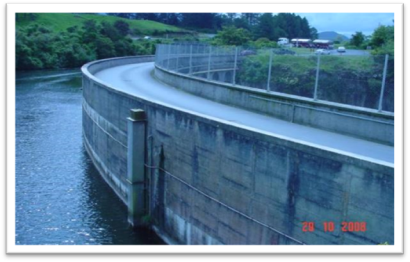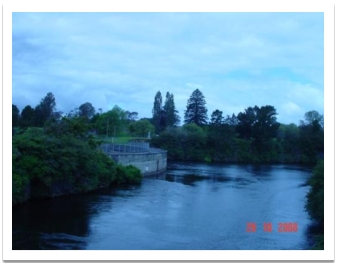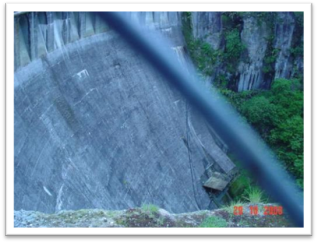HH-03: Arapuni Dam

Date of Photograph: 29/10/2008
Location and Zoning Information | |
Address |
Arapuni Rd, Arapuni |
Current Owner |
Mercury Energy Ltd |
Legal Description |
|
Zoning |
SPZ-ELG |
Valuation Number |
0541223500 |
Google Maps Link |
|
Architecture | |
Date of Construction |
1924 - 1929 |
Materials |
Curved gravity dam; reinforced concrete, foundations excavated 9.1m below the river bed. |
Architecture/Engineer/Builder |
F.W. Furkett, Engineer-In-Chief. Engineer: Frederick Templeton Manheim Kissel (1881-1962).Builder: Sir William G. Armstrong, Whitworth and Co. Ltd of Newcastle-On-Tyne 1924-Dec 1927. NZ Public Works Department Dec 1927-1929. |
Condition |
Good condition and high level of integrity. (HNZPT). Height from bottom of foundations to roadway 64.05m. Maximum thickness at base 52.15m. Length at crest 93.64m. Total concrete in dam 155,000 tons. Erection of 2.0m fence to existing balustrade on the downstream side of dam in 2001. (HNZPT). A locked fence limits access to base of the dam. Dam safety is reviewed every 5 years as part of Mighty River Power's dam safety management programme. Mighty River Power monitors groundwater levels, pressures and drainage flows in and around the dam. The company follows the guidelines of the NZ Society of Large Dams. A gas pipeline runs along the downstream face of the dam. (Mighty River Power, Feb 2001). |
Original Site Recommendation |
HNZPT Ref: 4154. Heritage Advisor, HNZPT. Additional information can be found in "The History of Arapuni" I.J. Southward. |
Current Use |
Hydro-electricity generation |
Statement of Significance | |
(1 Historical) - was associated with events, persons, organisation, institutions or ideas of importance in South Waikato History, Chief Engineer FW Furkett. Reflects important or representative aspects of South Waikato and New Zealand history, hydro electric power scheme in NZ, first state hydro dam on the Waikato River, public works. (6 Educational) has the potential to educate public about the history of South Waikato, item on a potential heritage trail, school programme potential/study of technology/engineering. (9 Technological) - was important in the development of technology, technological innovation or technological processes, unprecedented engineering project, scale larger than anything attempted before, geological problems had to be solved. (11 Context) - forms part of a wider historical and cultural complex, Arapuni Power Station and township. (13 Integrity) has a good level of integrity, good condition, no additions or major alterations. District Plan RulesDemolition - NC. Protection focus - 1, 6, 9 and 11. Mitigate the effects of demolition by requiring the applicant to provide Historical Building Documentation (HBD) which should include: the structure history, photographic documentation and measurements of the item prior to removal. Alterations necessary for the primary purpose of improving structural performance, fire safety or physical access – CON -Refer to HH-R2. Other Additions/Alterations - DIS. Protection focus - 1, 9, 11 and 13. Repair of the Structure - PER. Refer to HH-R1. Protection focus - 9, 11 and 13. Building Materials Rule: If repair of the buildings is proposed the materials used for the exterior walls should be similar in type, dimensions and profile as the existing exterior fabric of the building. Design Rule: Repair and replication work should match the existing design and profile of the element. Re-use/Change of Use - PER. Refer to HH-R1. Protection focus - 1, 9 and 13. Internal Changes - Not applicable. Relocation - Not applicable. Disturbance of the site surface/earthworks - Note: Any place that was associated with human activity prior to 1900 and is able to provide evidence relating to the history of New Zealand is an 'archaeological site' (refer to definition of 'archaeological site' in Section 2 of the Heritage New Zealand Pouhere Taonga Act 2014). All archaeological sites are protected under the Heritage New Zealand Pouhere Taonga Act 2014 and approval from Heritage New Zealand must be obtained prior to destroying, damaging or modifying any site. Accordingly, where this site on which a building is located is an 'archaeological site' and the building is to be repaired, added to, relocated or demolished and this involves disturbance to the surface and/or subsurface of the site, approval from Heritage New Zealand is required.
| |
History | |
The Arapuni complex (Dam, Powerhouse and associated works) proposal was of an unprecedented magnitude in New Zealand engineering. Public doubts were raised about the Public Works Department ability to undertake the project. In the end the Department's layout and design were adopted but overseas contractors, Armstrong, Whitford & Co Ltd, carried out construction. The first electricity from the dam was delivered on 4 June 1929. Power generation was stopped in 1930 when damage to the station was sustained as a result of significant rock movement. The geology of the site was not well understood and in 1930, following the filling of dam, water under pressure invaded the fractured rhyolitic breccia of the gorge walls, causing significant movement of the rock, and damage particularly to the powerhouse. The station was closed down and the lake level was lowered. Remedial work carried out by the Public Works Department including extensive concrete grouting of the abutment and foundation rock, sealed off the water and the rock largely returned to its original state, and structural damage to the power station was repaired. Generation of electricity resumed in April 1932. (HNZPT).
| |
Additional Photographs


